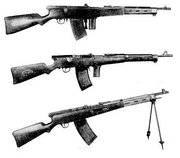Assault rifle
|
|
Assault rifles are selective fire intermediate-power rifles.
| Contents |
History
The first true assault rifle was probably the Italian-made Cei-Rigotti, which was developed around the beginning of the 20th century but never entered military service. The first service assault rifle was the Russian Federov Avtomat of 1916 chambered for the Japanese Arisaka 6.5×50 mm rifle cartridge, which due to supply problems was only used in small numbers. After these early starts, the idea of the assault rifle was mostly left dormant.
An attempt to provide soldiers with a rifle with an intermediate-power ammunition and heavier than submachine guns (too weak and with too short a range due to the pistol ammunition), but lighter than long rifles (uncomfortable to shoot, and difficult to control on full-automatic because of the powerful ammunition and more expensive to design and manufacture), by the Italian arms company Beretta resulted with its MAB 38 (Moschetto Automatico Beretta 1938).
The MAB 38 used a Fiocchi 9M38 cartridge, a higher-powered 9 mm Parabellum, which could provide a longer range. The useful range was about 200 m, although it was declared at 500 m. The MAB 38 was a multipurpose weapon.
Germany had studied the problem since WWI, and their factories made a variety of non-standard cartridges, so they had less incentive to remain with their existing calibers. At first they were still using the 8×57JS and 8mm Mauser. The 7.92×30 mm cartridge was the best of that production, and in 1941 it was improved to 7.9×33 mm Infanterie Kurz Patrone. In 1942 it was improved again as Maschinenkarabiner Patrone S and in 1943 Pistolen Patrone 43mE, then finally Infanterie Kurz Patrone 43. All these names follow the troubled creation of the Stg 44.
In 1942 Walther presented the Maschinenkarabiner (automatic carabine, abbr. MK), named MKb42(W). In the same year, Haenel presented the MKb42(H), designed by Hugo Schmeisser as a result of this program. Rheinmetall-Borsig (some said Krieghoff) presented its FG-42 (Fallschirmjaeger Gewehr 42) though this was was in a different role, and using a heavy 8×57 mm cartridge. The FG-42 was sponsored by Hermann Göring.
War-time tests in Russia indicated the MKb42(H) was the best of the three. Schmeisser developed it first as the MP43, then MP43/1 and finally as the STG 44 Sturmgewehr. It immediately entered large scale production. More than 5,000 pieces had been produced by February 1944, 55,000 by the following November.
Statistical studies of real battles performed by the U.S. Army indicated that combat beyond 200 yards is rare. The Russians saw no reason to make a rifle that shoots beyond a rifleman's ability to aim. Therefore a lighter, less-powerful cartridge could be effective. This permitted a lighter rifle and enabled troops to carry more ammunition, making them more autonomous. The lighter ammunition would use far less cargo capacity on trains, trucks, ships and helicopters. This reduced the cost of resupply. In addition, the smaller size and easy handling of an assault rifle would reduce the burden on tank crews, support troops, and units with missions other than front line combat. All of these led to the widespread adoption of assault rifles.
Since WWII, many nations have developed assault rifles, some very soon after the end of the war, while others continued the development of high-powered battle rifles with ranges beyond 500 meters until the 1960s. Examples of battle rifles are the Belgian FN FAL and the German HK G3.
In the US, the term has recently been modified as "assault weapon" and applied (for political reasons) to various semi-automatic firearms. Arms manufacturers had for decades advertised the supposed resemblance of their civilian products to military weapons.
Effects on doctrine and organization
Studies by the U.S. Army indicate that most conflicts between soldiers occur at ranges of 100 meters or less. Russian doctrine asserts that the typical soldier is unable to aim beyond 400 meters, and therefore 400 m should be the ultimate aimed range of a rifle for massed fire. These studies influenced the basic design of the assault rifle, which caused ordinary soldiers to become less able to fire accurately at long ranges. However, Russian and Russian-derived doctrines include squad-level snipers, while the U.S. and its derived doctrines maintain a sniper team at battalion level.
Unrelated Terms
In the United States, the term 'assault weapon' was used in certain groups primarily to describe a collection of semi-automatic firearms that have certain features, such as a magazine larger than ten rounds or a folding stock. It has been used primarily in relation to a specific Gun law, a bill commonly known as the 'Assault Weapons Ban', 'Clinton gun ban' or '1994 crime bill', although weapons capable of automatic fire, including assault rifles, have been under heavy restrictions since the 1930s in the US and were not affected by this now-expired law.
See also
External links
- Assault Rifles and their Ammunition: History and Prospects (http://www.quarry.nildram.co.uk/Assault.htm)de:Sturmgewehr
fr:Fusil d'assaut lt:Automatas pl:Karabinek szturmowy ru:Штурмовая винтовка sl:Jurišna puška fi:Rynnäkkökivääri zh:突击步枪

